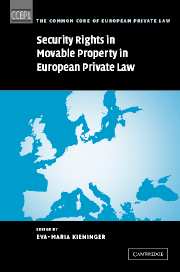Book contents
- Frontmatter
- Contents
- General editors' preface
- Preface
- List of contributors
- Table of cases cited by name
- Table of legislation
- Part I Introduction and context
- List of abbreviations
- 1 Introduction: security rights in movable property within the common market and the approach of the study
- 2 A labyrinth of creditors: a short introduction to the history of security interests in goods
- 3 Security in movables in the United States – Uniform Commercial Code Article 9: a basis for comparison
- 4 The English law of security: creditor-friendly but unreformed
- 5 The European Bank for Reconstruction and Development's Secured Transactions Project: a model law and ten core principles for a modern secured transactions law in countries of Central and Eastern Europe (and elsewhere!)
- Part II The case studies
- Index by country
- Index by subject
2 - A labyrinth of creditors: a short introduction to the history of security interests in goods
Published online by Cambridge University Press: 23 December 2009
- Frontmatter
- Contents
- General editors' preface
- Preface
- List of contributors
- Table of cases cited by name
- Table of legislation
- Part I Introduction and context
- List of abbreviations
- 1 Introduction: security rights in movable property within the common market and the approach of the study
- 2 A labyrinth of creditors: a short introduction to the history of security interests in goods
- 3 Security in movables in the United States – Uniform Commercial Code Article 9: a basis for comparison
- 4 The English law of security: creditor-friendly but unreformed
- 5 The European Bank for Reconstruction and Development's Secured Transactions Project: a model law and ten core principles for a modern secured transactions law in countries of Central and Eastern Europe (and elsewhere!)
- Part II The case studies
- Index by country
- Index by subject
Summary
Introduction
The history of security interests in movables on the European continent begins with the ‘reception’ of Roman law in the guise of Justinian's Corpus Iuris Civilis in the Middle Ages. As with any code, Justinian's codification forms the conclusion of an era in the development of the law. Legal concepts not incorporated into the code, like the ancient fiducia cum creditore, were consequently concealed from the legal consciousness for ages, until some of them were drawn from the collective subconscious of the civil law in the course of the nineteenth century. An assessment of the Roman origins of the continental European system of security interests in movables is important, particularly since many aspects of the modern system have been consciously developed as a reaction to the Roman system. The current statutory provisions on the creation of a valid pledge, for example, are only comprehensible if it is appreciated that they were formulated as a response to the deviating provisions of Roman law. It will, therefore, be necessary to glimpse briefly the Roman system of security interests in movables as contained in Justinian's codification.
Justinian Roman law
After the demise of the concept of fiducia, Roman law recognised only two proprietary security interests, pignus and hypotheca.
- Type
- Chapter
- Information
- Publisher: Cambridge University PressPrint publication year: 2004
- 22
- Cited by



